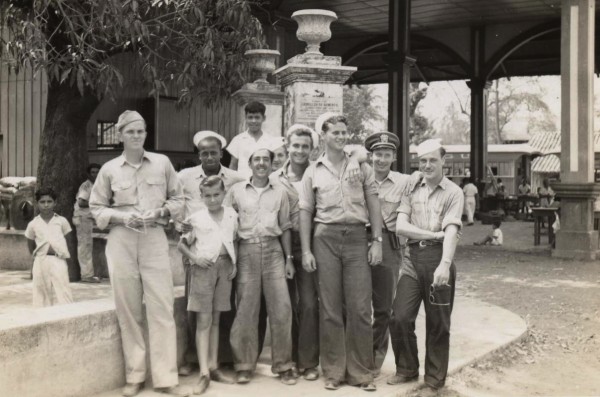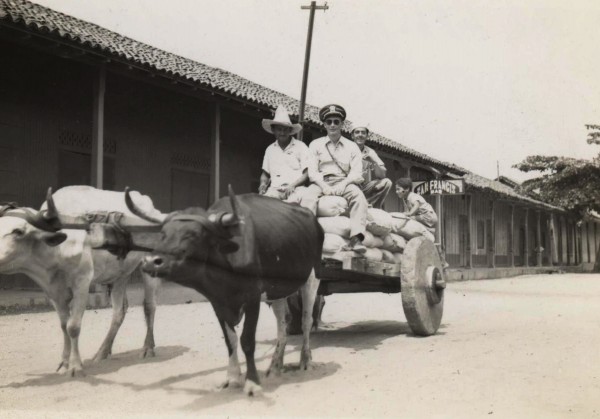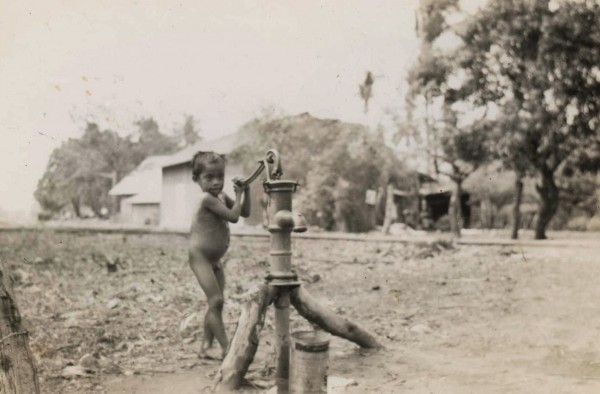Some months ago, I was contacted by a sailor who served aboard a sibling minesweeper across the American, European, and Pacific theatres of WWII. Lieutenant Marty Roberts of Raleigh, NC served aboard YMS-468 as Engineering Officer and later Deck Officer, from 1943 to 1946. Marty wrote up this biography of his naval service for his grandson and was kind enough to share it and his photographs with us.
This post is an eight-part series. Below is an index of all parts. Enjoy!
Marty Roberts of Raleigh, NC | February 28th, 2014
Navy Days – A Letter to Joe
- Part 1: In training
- Part 2: YMS-468 on the US East Coast
- Part 3: YMS-468 through Panama Canal, in prep for battle
- Part 4: YMS-468 on the US West Coast, into the Pacific Theatre
- Part 5: YMS-468 in battle, up to Japan’s surrender
- Part 6: YMS-468 in Makurazaki Typhoon
- Part 7: YMS-468 moored in Japan’s occupation
- Part 8: After the war
Part 3 of 8: YMS-468 through Panama Canal, prep for battle
Once the war in Europe was over we got orders to head for the Pacific and join the effort to finish off the Japanese. We headed South through the Caribbean (I loved the music we picked up from the islands along the way) to Panama stopping at Coco Solo on the North end of the canal for a short bit of shore leave. Each ship was required to assign an officer and two men to shore patrol duty to police the place and I drew the short straw for a 4 to 8 watch and had to report to the local police station for assignment. My men and I were instructed to relieve the watch at the “Pension Americana” and our orders were to “keep the peace” on the second deck! There was a steady traffic of soldiers, sailors, and marines up the stairs and down the hall. One soldier came up the stairs and I recognized him from my hometown. His reaction was “don’t tell Mom you saw me here!”
Later, several Marines from the aircraft carrier USS Franklin appeared. Their ship was returning to the East Coast for extensive repairs after being badly damaged by Kamikazes and this was their first shore leave. They’d had a lot to drink and the girl one of them was “visiting” in a room down the hall began to scream out loud. I went in to find him strangling her by the neck claiming she didn’t give him the change she owed him after he paid her. I called down the hall for a couple of his buddies to get him out of the place and take care of him so I didn’t have to put him on report. They did and peace was restored, the girl recovered and in fact we found that the change she gave him somehow got kicked under the bed.
Passage through the Panama Canal was uneventful and we proceeded up the Central American coast stopping at Nicaragua to refuel. This was a poverty-stricken country, as you can see from these pictures.

Nicaragua; mix of YMS crew and locals while on shore leave; Far left, front: Al B Wiles, Lieutenant (jg) (Skipper, Commanding Officer) of Jackson, MS; Dark officer’s hat, right: Clint J Hill, Ensign (Communications Officer); 1945
We arrived at our destination at the Long Beach Naval Base near LA, California to learn we would spend a couple weeks preparing for the trip to the activity in the Western Pacific. With this prospect, Muriel now pregnant, decided to travel clear across the country to be with me before we shipped out. I was thrilled but apprehensive because air travel was impossible and train travel very difficult. But as you may remember when your grandma made up her mind there was no way to change it. She had to sit up all the way to Chicago when some very kind man gave up his reservation so she could have berth accommodations the remainder of the trip! So your mother started major traveling even before she was born!
In addition to usual preparations like taking on supplies, ammunition, engine checkouts, training, etc., we also took aboard a number of large green and brown painted sealed boxes and were told not ask what they contained! More about this later. When I had the 4 to 8 watch Muriel would come down to the ship and we would spend the time in the wardroom playing Honeymoon Bridge. This is a two-handed bridge game and a good way to learn the basic rules of bridge. Muriel was always an excellent bridge player and had the incredible ability to memorize all the cards she was dealt and never had to sort her hand!
All too soon we had to say goodbye and Muriel headed back to the East Coast and I headed West to new adventures in the Pacific. We had an uneventful cruise to Hawaii and put into Pearl Harbor to refuel and resupply. The only technical problem we experienced with the ship so far was that every once in a while one of our two 500 HP GM diesel main engines would quit running. This started while we were still on the East Coast and I discovered the cause and reported it to BuShips several times. The fault was with the fuel injector filters. The original design used “stacked disc” filters which worked just fine, but someone had a bright idea that these should be replaced with better filtering “sintered bronze” type filters and we were ordered to do so. In the lab I’m sure these performed better, but what the designers did not realize was that in practice the diesel fuel we had to take on was often contaminated with salt water which caused the sintered bronze to begin to disintegrate and flakes of bronze would foul the very close tolerance between the piston and cylinder wall of the injector causing it to seize up and shut down. At every port we put into I reported the problem and told my Machinist Mate (MoMM) to requisition the old type or even steal some if he had to!
Our Exec, Dave Stafford, had a brother in the Air Force and we discovered he was in Pearl, too, so we got together and he took us on a sightseeing flight over the islands which enabled us to see the volcano on the main island of Hawaii, the city of Hilo, etc. He also got us a couple bottles of bourbon from their Officer’s Club which we secreted aboard for possible medical use later on! I was assigned the responsibility of keeping these secure along with a gallon of pure ethyl alcohol (for use in cleaning the lenses of our signal lights). I kept them under my sack in officer’s quarters.
This post is an eight-part series. Below is an index of all parts. Enjoy!
Marty Roberts of Raleigh, NC | February 28th, 2014
Navy Days – A Letter to Joe
- Part 1: In training
- Part 2: YMS-468 on the US East Coast
- Part 3: YMS-468 through Panama Canal, in prep for battle
- Part 4: YMS-468 on the US West Coast, into the Pacific Theatre
- Part 5: YMS-468 in battle, up to Japan’s surrender
- Part 6: YMS-468 in Makurazaki Typhoon
- Part 7: YMS-468 moored in Japan’s occupation
- Part 8: After the war

